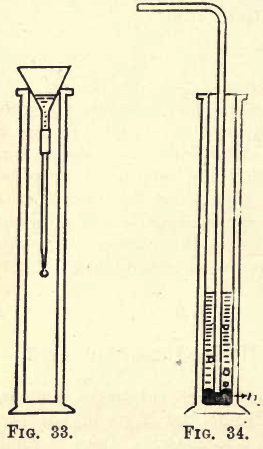Bromine Gas
In the preparation of bromine, fix up your apparatus as for the preparation of nitric acid, surrounding the receiver with cold water. Mix about 4 grams of manganese dioxide with 2 grams of potassium bromide, transfer to the retort carefully, and add a little strong sulphuric acid; then replace the stopper in the retort and […]
Iodine Gas

Mix about 1 or 2 grams of potassium iodide with about twice its weight of manganese dioxide, and transfer the mixture to a flask fixed on a retort stand, then add a few c.c. of strong sulphuric acid (do not fit a cork into the flask); violet fumes soon appear, and condense in the neck of […]
Hydrofluoric Acid, Silicon Fluoride

Hydrofluoric acid can be prepared by the action of sulphuric acid on fluorspar (calcium fluoride), but glass apparatus cannot be used in the preparation on account of the action of this gas on the glass. Take a small round piece of sheet lead about 3 inches in diameter, and with the pestle press the centre […]
Sulphur Dioxide Gas
Fix up your apparatus as in the preparation of carbon dioxide, only set your flask on a retort-stand, so that it can be heated. Take about 20 grams of copper shavings or clippings and put them carefully into the flask, add through the thistle funnel about 60 c.c. of strong sulphuric acid, and heat up […]
Sulphur Trioxide Gas
The Sulphur Trioxide Gas Laboratory experiments starts when you pour about 10 c.c. of strong Nordhausen sulphuric acid (H2S2O7) into a small retort to which is attached a receiver; heat the retort carefully, and fumes of sulphur trioxide will pass over and condense to a white crystalline solid in the receiver. H2S2O7 = H2SO4 + […]
Crystallisation of Gold

Gold crystallises in the cubic system, occurring frequently in nature in the form of cubes, octahedra and rhombic dodecahedra. Cleavage is never exhibited. Single detached crystals are comparatively rare, and the crystals are usually attached end to end, forming strings, and branching, arborescent, or moss-like masses, which are composed of microscopic crystals, usually octahedra. These […]
Silver Chlorination Leaching by Trough Method
In tank-lixiviation of silver by chlorination, the extraction of the silver from chloridized ore by solutions of hyposulphite salts is performed by filtration. The ore-particles are kept stationary, while the solvent moves down through the mass of ore. The quickness of extraction, other conditions alike, is in direct proportion to the rapidity of the movement […]
Silver Ingot Melting
The method of making silver ingots in use at this Mint being radically different from that employed at any other Mint of the United States or, so far as known to me, any Mint in the world, there may be some interest in a description of the apparatus used and a brief history of its […]
Gold Prospecting Methods
The modern gold prospector has advantages that to some extent make up for the increased difficulty of finding ore deposits. One advantage is greatly increased knowledge about the geologic factors that localize ore deposition. The search for new deposits has become a complex undertaking, and the prospector should be as well-informed as possible. The […]
Prospecting for Minerals
Prospectors have made a tremendous contribution to the development of this Nation’s mineral resources. Since the time of the earliest settlement, the need for iron for tools and guns, lead for bullets, and copper for utensils has prompted a search for sources of these metals. The lure of gold and silver provided the impetus for […]
